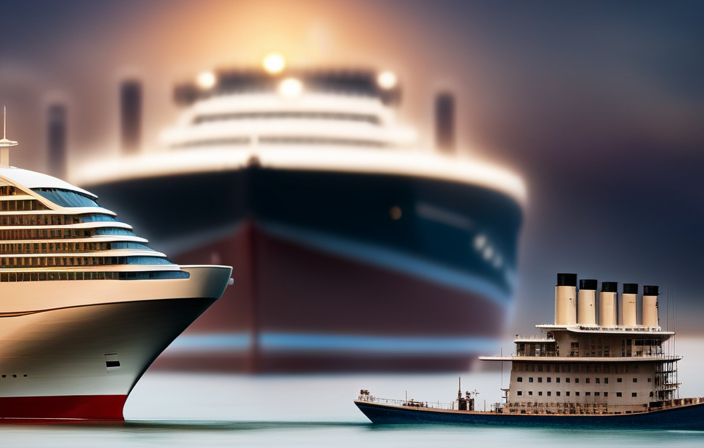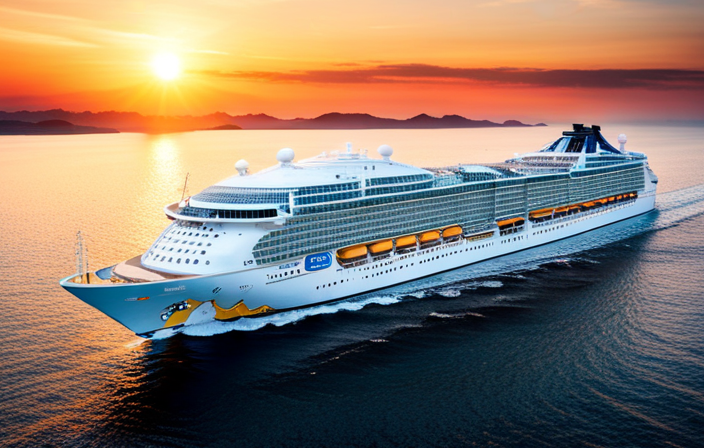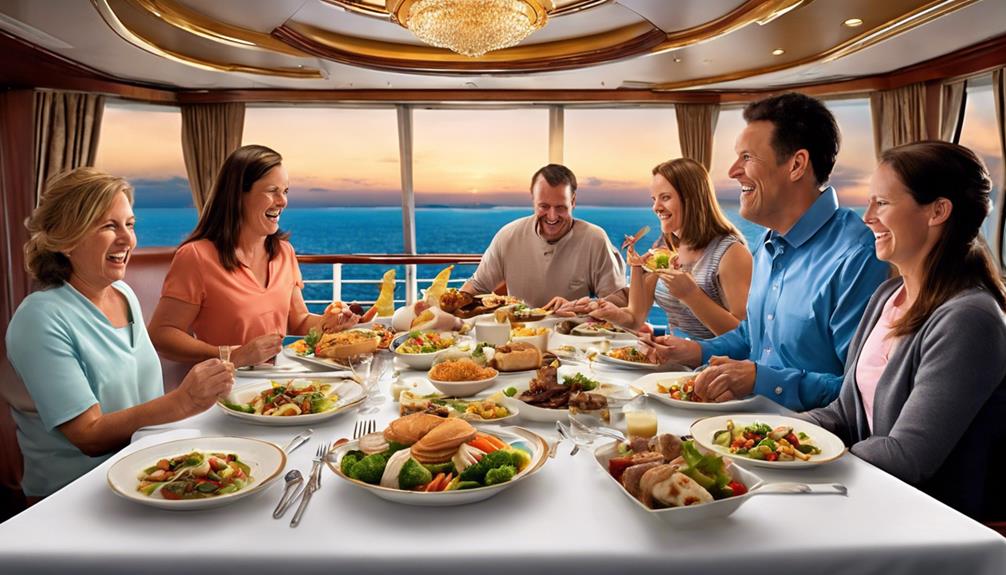Ah, the mesmerizing world of cruise ships. Have you ever wondered about the inner workings of these floating cities? Let me, your guide, take you on a journey to uncover the secrets of how a cruise ship truly operates.
From the moment you step foot on that magnificent ship to the time you bid it farewell, a carefully orchestrated symphony of operations takes place. Embarkation and disembarkation procedures ensure a smooth transition between shore and sea.
The cozy cabin accommodations become your home away from home, while the dining arrangements tantalize your taste buds with a plethora of delectable options.
Prepare to be entertained with a variety of onboard activities and shows that will leave you in awe. And let’s not forget the thrilling excursions and port visits that await you at every destination.
Safety and emergency procedures are always in place, ensuring your peace of mind. The dedicated cruise staff and crew work tirelessly behind the scenes to create a seamless experience for you.
So, my dear reader, fasten your seatbelts and get ready for an extraordinary journey as we dive into the inner workings of how a cruise truly works.
Key Takeaways
- Cruise ships have strict emergency preparedness measures in place, including mandatory life jacket drills, passenger training on emergency procedures, and detailed evacuation plans.
- Onboard medical facilities are available 24/7 and staffed with highly trained medical professionals who can handle a range of medical issues, from basic care to emergency treatment.
- Cruise ships have a variety of crew members and departments, each with specific roles and responsibilities to ensure smooth operation and exceptional service.
- Passengers should be familiar with tipping guidelines, onboard dress codes, and alcohol policies, and follow specific instructions during the debarkation process to ensure a smooth transition from ship to shore.
Embarkation and Disembarkation Procedures
The embarkation and disembarkation procedures on a cruise ship can be quite efficient, ensuring that passengers can smoothly transition from land to sea and back again.
The embarkation process begins with check-in at the port, where passengers present their identification and receive their cruise cards. Once onboard, guests are directed to their designated muster stations for a mandatory safety drill. After this, passengers are free to explore the ship and settle into their cabin accommodations.
On the final day of the cruise, the disembarkation process is initiated. Passengers are provided with specific disembarkation times and are required to pack their belongings and place them outside their cabins the night before. On the designated time, guests proceed to the designated areas to disembark the ship and continue their journey ashore.
Cabin Accommodations
Imagine stepping into your cozy cabin, feeling the gentle sway of the ship as you make yourself at home for the duration of your extraordinary voyage. The cabin accommodations on a cruise ship are designed to provide comfort and convenience, with various options available to suit different preferences and budgets.
The cabin decor is carefully chosen to create a welcoming and relaxing atmosphere, with tasteful furnishings and soothing colors. If you’re looking for a little extra luxury, cabin upgrades are available, offering additional space, private balconies, and exclusive amenities. Whether you choose a standard cabin or indulge in a suite, you can expect a high level of cleanliness and attention to detail.
As you settle into your cabin, you can start exploring the ship and discovering the many dining options available. From formal dining rooms to casual buffets, there’s something to suit every taste.
Transitioning into the next section, let’s delve into the delightful dining arrangements on board.
Dining Arrangements
Once you’ve settled into your cabin, you’ll find a wide array of dining options to satisfy your palate on board the cruise ship. Whether you’re a foodie looking for a gourmet experience or prefer casual dining, there’s something for everyone. The ship offers various restaurants, cafes, and buffet areas where you can indulge in a diverse range of cuisines, from Italian to Asian fusion. To make your dining experience even more convenient, the cruise ship offers different meal plans, including all-inclusive options or à la carte dining. You can choose to dine at a specific time or opt for flexible dining, allowing you to eat whenever you please. The ship’s dining venues are designed to accommodate different tastes and dietary restrictions, ensuring that everyone can enjoy their meals onboard. With your appetite satisfied, you can then transition into the subsequent section about onboard activities and entertainment, where you’ll discover a wealth of exciting experiences to enhance your cruise journey.
Onboard Activities and Entertainment
Get ready to immerse yourself in a world of thrilling activities and captivating entertainment options that’ll leave you spellbound throughout your cruise journey. Here are three onboard activities and entertainment options that’ll make your cruise experience unforgettable:
-
Onboard Shows: Prepare to be amazed by the world-class performances and dazzling productions that take place on the cruise ship. From Broadway-style musicals to comedy shows, there’s something for everyone to enjoy.
-
Recreational Activities: Whether you’re seeking adventure or relaxation, the cruise ship offers a wide range of recreational activities. Take a dip in the pool, try your hand at rock climbing, or unwind in the spa. There are endless options to keep you entertained.
-
Theme Nights and Parties: Get ready to dance the night away at themed parties onboard. From tropical beach parties to elegant masquerade balls, these events are a perfect opportunity to socialize and have a great time with fellow cruisers.
As you embark on your cruise, you’ll also have the chance to explore exciting destinations during your excursions and port visits.
Excursions and Port Visits
When you step off the ship during your port visits, you’ll have the opportunity to explore exciting destinations and create unforgettable memories. Excursion planning is a crucial part of maximizing your time in each port.
Before your cruise, research the available excursions and decide which ones align with your interests and preferences. Whether it’s touring ancient ruins, snorkeling in crystal clear waters, or immersing yourself in the local culture, there’s something for everyone. These excursions allow you to delve deeper into the unique experiences each port has to offer.
From tasting local cuisine to interacting with the locals, you’ll gain a deeper understanding of the destinations you visit. Embrace the chance to step outside your comfort zone and explore the world.
As we move into the next section about cruise ship amenities and services, you’ll discover the numerous ways a cruise caters to your every need.
Cruise Ship Amenities and Services
Indulge in the luxurious offerings and pampering services of a cruise ship, where every desire is fulfilled and every need is met. Cruise ship amenities and services are designed to provide a truly indulgent experience for passengers.
One of the highlights is the onboard spa facilities, where you can rejuvenate your mind, body, and soul. From massages and facials to steam rooms and saunas, the cruise ship spa offers a wide range of treatments to help you relax and unwind.
Additionally, the onboard shopping options are a shopper’s paradise. Whether you’re looking for high-end designer brands or unique souvenirs, the cruise ship shops have it all. With a variety of duty-free products, you can indulge in some retail therapy while sailing to your next destination.
As we focus on ensuring your utmost safety and comfort, let’s explore the next section about ‘safety and emergency procedures.’
Safety and Emergency Procedures
When it comes to safety on a cruise ship, there are several key points to consider. First and foremost, the lifeboat drills are conducted to ensure all passengers know the proper procedures in the event of an emergency.
Additionally, cruise ships have detailed emergency evacuation plans in place, outlining the steps to be taken in various scenarios.
Lastly, cruise ships are equipped with medical facilities and services to provide assistance in case of any medical emergencies that may arise during the journey.
Lifeboat Drills
Lifeboat drills are crucial for the safety of passengers and crew members aboard a cruise ship. These drills ensure that everyone knows what to do in the event of an emergency. Here are five important things to know about lifeboat drills:
-
Lifeboat maintenance: Regular inspections and maintenance of lifeboats are conducted to ensure they’re in proper working condition.
-
Life jacket regulations: It’s mandatory for all passengers and crew members to wear life jackets during lifeboat drills.
-
Emergency signals: During the drill, passengers learn to recognize and respond to emergency signals, such as alarms and announcements.
-
Boarding procedures: Passengers are taught how to safely board the lifeboats, including the correct way to enter and secure themselves inside.
-
Role assignments: Crew members are assigned specific roles and responsibilities during the drill, ensuring an organized and efficient evacuation process.
These drills prepare everyone on board for emergency evacuation plans, which will be discussed in the next section.
Emergency Evacuation Plans
Passengers and crew members must familiarize themselves with emergency evacuation plans in order to ensure their safety in case of an emergency, but how can they effectively prepare for such unpredictable situations?
Cruise ships have well-designed emergency evacuation plans that are regularly practiced through drills. These plans outline the procedures to be followed in the event of an emergency, including the locations of lifeboats, muster stations, and evacuation routes.
Passengers are provided with detailed information about these plans upon boarding the ship, and crew members are trained to guide and assist them during emergencies. Additionally, cruise ship amenities such as public address systems, emergency lighting, and clear signage help facilitate a swift and organized evacuation process.
With these comprehensive emergency evacuation plans in place, passengers and crew members can have peace of mind knowing that their safety is a top priority.
Moving on to medical facilities and services, cruise ships are equipped with…
Medical Facilities and Services
Onboard medical facilities and services are essential for the well-being of passengers and crew members, offering necessary healthcare support during their cruise journey. These facilities are equipped with state-of-the-art medical equipment and staffed by highly trained healthcare professionals. The cruise ship’s medical center is typically open 24 hours a day, ensuring that medical assistance is available at all times. The medical staff can provide a wide range of services, including basic medical care, emergency treatment, and even minor surgeries. They are equipped to handle common illnesses and injuries, as well as more serious medical emergencies.
Here is a table that provides an overview of the medical facilities and services available onboard a cruise ship:
| Medical Facilities | Services |
|---|---|
| Fully equipped medical center | Basic medical care |
| 24-hour availability | Emergency treatment |
| State-of-the-art equipment | Minor surgeries |
| Highly trained medical staff | Common illnesses and injuries |
| Serious medical emergencies |
Moving on to the next section about cruise staff and crew, it is important to understand the roles they play in ensuring a smooth and enjoyable cruise experience.
Cruise Staff and Crew
As a cruise staff member, my role and responsibility is to ensure the smooth operation of the ship and provide exceptional service to guests. I’m responsible for assisting guests with any needs or concerns they may have, whether it be making reservations, organizing activities, or providing information about the ship and its amenities.
Additionally, I’m knowledgeable about the tipping and gratuity guidelines on board and can provide guidance to guests on how to show appreciation for the hard work of the crew.
Roles and Responsibilities
Crew members are crucial to ensuring the smooth operation of a cruise ship, with each individual having specific roles and responsibilities. The crew is divided into departments, with each department overseeing different aspects of the ship’s operations.
For example, the deck department is responsible for navigation, safety, and maintenance of the ship’s exterior. The engineering department takes care of the ship’s engines, generators, and other mechanical systems. The housekeeping department ensures that the cabins and public areas are clean and well-maintained. The food and beverage department manages the ship’s restaurants and bars, providing guests with delicious meals and drinks.
Additionally, there are departments dedicated to entertainment, guest services, and security. Overall, the crew works together to provide exceptional service to guests and ensure their safety throughout the cruise.
As we move on to the section about guest services and assistance, it’s important to highlight the crew’s dedication to making every guest’s experience unforgettable.
Guest Services and Assistance
Get ready to experience a level of service that will blow your mind and leave you feeling like royalty. Guest services and assistance on a cruise ship are unmatched.
From the moment you step on board, a team of dedicated staff members is there to cater to your every need. Whether it’s booking excursions, making dinner reservations, or simply providing information, the guest services desk is available 24/7.
If you require any special accommodations or have specific dietary needs, the staff will go above and beyond to ensure your comfort. Additionally, there are trained medical professionals on board to provide any necessary assistance. With their expertise and genuine care, you can relax and enjoy your vacation worry-free.
Speaking of relaxation, let’s talk about tipping and gratuity guidelines for the exceptional service you’ll receive on your cruise.
Tipping and Gratuity Guidelines
Prepare to show your appreciation for the exceptional service you’ll receive on your cruise by familiarizing yourself with the tipping and gratuity guidelines. Tipping guidelines vary by cruise line, but a general rule of thumb is to tip around $10 to $12 per day, per person for your cabin steward and dining room staff. However, some cruise lines automatically add gratuities to your onboard account, so be sure to check your cruise line’s policy. It’s also customary to tip your bartenders, spa staff, and other service providers throughout the ship. To help you plan, here’s a table outlining the suggested gratuity amounts for different positions:
| Position | Suggested Gratuity |
|---|---|
| Cabin Steward | $10-$12 per day |
| Dining Room Staff | $10-$12 per day |
| Bartenders | $1-$2 per drink |
By adhering to these gratuity etiquette guidelines, you ensure that the hardworking crew members are appropriately recognized for their outstanding service. Now, let’s explore the onboard policies and etiquette to make the most of your cruise experience.
Onboard Policies and Etiquette
Passengers should be aware of the onboard policies and etiquette in order to ensure a smooth and enjoyable cruise experience.
One important aspect to consider is the onboard dress code. Most cruise lines have dress codes for different areas of the ship, such as formal nights in the main dining room or casual attire for daytime activities. It’s essential to pack accordingly and adhere to these guidelines to avoid any embarrassment or inconvenience.
Additionally, each cruise line has its own alcohol policies. Some allow passengers to bring their own alcohol on board, while others prohibit it. It’s crucial to familiarize yourself with these policies to avoid any issues during your trip.
As you prepare for the end of your cruise, it’s important to understand the debarkation and post-cruise procedures, which will be discussed in the subsequent section.
Debarkation and Post-Cruise Procedures
After enjoying a fantastic cruise experience, it’s time to disembark and return to the real world. The debarkation process is a well-organized procedure that ensures a smooth transition for all passengers. As the ship arrives at the port, guests are given specific instructions on when and where to gather their belongings and leave the ship.
Customs clearance is an important part of the debarkation process, where passengers must declare any items they’re bringing back home. Here are some key points to keep in mind during the debarkation and post-cruise procedures:
- Organize your belongings and make sure you have all your personal items.
- Follow the instructions provided by the crew for debarkation.
- Prepare necessary documents for customs clearance.
- Be patient and follow the established procedures to ensure a hassle-free departure.
Remember, the debarkation process is designed to make your transition from ship to shore as smooth as possible.
Frequently Asked Questions
What is the dress code for onboard activities and entertainment?
The dress code for onboard activities and entertainment varies, but generally, cruise lines recommend a smart-casual attire during the day and resort casual or formal attire in the evenings. It’s important to follow the dress code etiquette to ensure a pleasant experience.
Can I bring my own alcohol on board?
Sure, you can bring your own alcohol on board, but there may be restrictions and fees. As for pets, most cruises don’t allow them, but some offer pet-friendly options. Smoking policies vary by cruise line.
Are there laundry facilities available on the cruise ship?
Yes, there are laundry facilities available on the cruise ship. You can easily take care of your clothing options during your voyage. The ship provides convenient and efficient laundry services for your convenience.
How can I stay connected to the internet during the cruise?
To stay connected during the cruise, I use the ship’s onboard Wi-Fi. Internet access is available in most areas, and I can easily connect my devices to check emails, browse the web, and stay connected with friends and family.
Are there any age restrictions for onboard activities and entertainment?
Yes, there are age restrictions for onboard activities. The cruise provides a variety of entertainment options, but some may have age restrictions for safety reasons or to maintain a certain atmosphere.
How does the layout of a cruise ship affect its functionality and operations?
The layout of a cruise ship can significantly impact its functionality and operations. From the front of the cruise ship called the bow to the back, each area serves a specific purpose, such as accommodating guests, housing the engine room, or providing access to recreational facilities. Efficient design is crucial for smooth operations.
Conclusion
In conclusion, experiencing a cruise is like embarking on a majestic voyage through the vast ocean, where every moment is filled with excitement and wonder.
From the smooth embarkation and disembarkation procedures to the cozy cabin accommodations, delightful dining arrangements, and thrilling onboard activities and entertainment, a cruise offers a world of possibilities.
With the guidance of the dedicated cruise staff and crew, along with strict safety measures and emergency procedures in place, you can sail with confidence.
So, come aboard and let the rhythm of the waves carry you to unforgettable destinations and memories that’ll last a lifetime.










